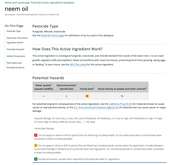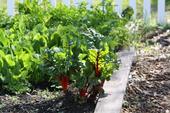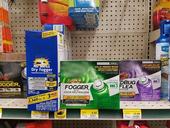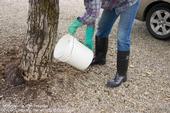- Author: Lauren Fordyce

The University of California Statewide IPM Program (UC IPM) has an exciting, newly updated resource to help you better understand pesticide active ingredients and the risks different active ingredients pose to people and the environment.
The Pesticide Active Ingredient Database is designed for urban audiences including the general public, Master Gardeners, nursery and garden center staff, pest control operators, landscapers, and more. The active ingredients included in this database can be found in many commonly available pesticide products in California. The database contains a variety of pesticide types, including...

If your company does residential landscape pest control, your employees should be trained to know what to do when they encounter a vegetable garden, or fruit or nut trees in a yard (Figure 1). Their training should include how to answer a customer's questions about the safety of their pesticides around vegetables or herbs. Talking to a customer about the edible plants in their garden so you don't accidentally spray their plants might save that account from subsequent cancellation.
Is it appropriate for a technician to recommend that a resident simply wash their vegetables after having their yard treated for say, mosquitoes, or should the vegetables be thrown away? What about a perimeter spray around the home? The answer...
- Author: Belinda J. Messenger-Sikes
- Author: Lisa A Blecker
- Posted by: Elaine Lander

Insecticide foggers, also known as total release foggers or “bug bombs” (Figure 1), are popular products widely available in many retail nurseries and garden centers as well as drug stores, supermarkets, and convenience stores. These easy-to-use products may seem to provide an easy way to kill a lot of bugs fast and may be viewed as more convenient and cheaper than hiring a pest management professional. But do they work?
Are Foggers Effective?
Foggers can be used effectively to kill pests that are flying around or resting on surfaces, like flies, but there are better long-term and more effective...

[Originally published as “Pesticide Briefs: What Do These Terms Mean?” in the Fall 2018 issue of the Retail Nursery and Garden Center IPM News.]
Last summer, we defined what a pesticide is and gave a few examples. Here, we explore different types of pesticides, their specific uses, and pesticide related...
- Author: Andrew M. Sutherland

[From March 2014 issue of the Retail Nursery and Garden Center IPM News.]
A massive killing of bumblebees in Oregon, concerns about impacts on honey bees, and tight new regulations imposed by the European Union have kept neonicotinoid insecticides in the news. The neonicotinoid group includes imidacloprid, one of the most popular garden insecticides sold in stores.
First developed in the late 1980s, neonicotinoids represented the first new class of insecticides in over 50 years. They are insect nervous system toxins widely used in horticulture, agriculture, and structural...


